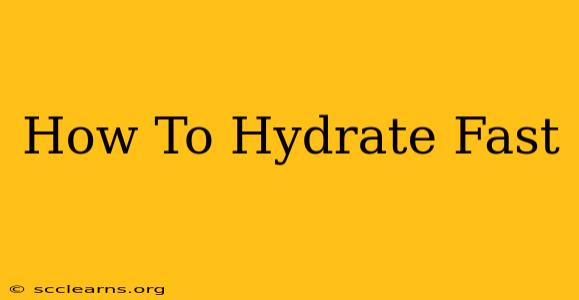Feeling parched? Dehydration can sneak up on you, leaving you feeling sluggish, headachy, and generally unwell. But don't worry, rehydrating quickly is entirely possible. This guide will walk you through effective strategies to replenish your fluids and get back on your feet.
Recognizing the Signs of Dehydration
Before diving into hydration solutions, it's crucial to understand the telltale signs of dehydration. These can vary in severity, ranging from mild discomfort to serious medical concerns. Pay attention to these symptoms:
- Dry mouth and throat: This is one of the most common and obvious signs.
- Decreased urination: Less frequent or darker-colored urine indicates dehydration.
- Fatigue and weakness: Feeling unusually tired or weak can be a sign your body needs fluids.
- Headache: Dehydration is a frequent cause of headaches.
- Dizziness or lightheadedness: A lack of fluids can affect blood pressure and lead to dizziness.
- Muscle cramps: Dehydration can disrupt electrolyte balance, causing muscle cramps.
- Dry skin: Your skin may appear less elastic and feel dry to the touch.
Severe dehydration requires immediate medical attention. If you experience intense symptoms like rapid heartbeat, confusion, or loss of consciousness, seek professional help immediately.
Fast Hydration Strategies: The Best Ways to Rehydrate Quickly
Now that you know the signs, let's explore how to hydrate fast and effectively:
1. Water, Water, Everywhere: The Foundation of Hydration
This might seem obvious, but water is your best friend when it comes to rehydration. Aim for clear, cool water as it's easily absorbed by your body. Avoid sugary drinks, as they can sometimes have a dehydrating effect.
2. Electrolyte Drinks: Replenishing Lost Salts
When you sweat, you lose electrolytes, essential minerals that regulate fluid balance. Electrolyte drinks, such as sports drinks, can help replenish these lost electrolytes, especially after intense physical activity. However, be mindful of added sugars in many commercial sports drinks. Consider low-sugar or sugar-free alternatives.
3. Hydrating Foods: Sneak in Extra Fluids
Did you know you can hydrate through food? Fruits and vegetables with high water content, such as watermelon, cucumbers, and spinach, can contribute significantly to your daily fluid intake.
4. Broth-Based Soups: A Warm and Hydrating Choice
Warm broths, especially those with vegetables and low sodium, can be incredibly soothing and hydrating, particularly when you're feeling unwell.
5. Coconut Water: A Natural Electrolyte Boost
Coconut water is a natural source of electrolytes and a refreshing way to rehydrate. It's a lower-sugar alternative to many commercial sports drinks.
6. Listen to Your Body: Hydration is Personalized
The amount of water you need will vary depending on factors like your activity level, climate, and overall health. Pay attention to your body's signals, and drink when you're thirsty.
Preventing Dehydration: Proactive Steps for Long-Term Hydration
While knowing how to hydrate fast is essential, preventing dehydration in the first place is even better. Here are some proactive strategies:
- Drink water throughout the day: Don't wait until you're thirsty. Keep a water bottle handy and sip regularly.
- Increase water intake during exercise: Sweat profusely during workouts? Ensure you consume extra fluids before, during, and after.
- Eat hydrating foods: Incorporate plenty of fruits, vegetables, and soups into your diet.
- Monitor your urine color: Pale yellow urine indicates good hydration. Darker urine is a signal to increase fluid intake.
- Adjust for climate and activity: In hot climates or with increased physical activity, your hydration needs will increase significantly.
By understanding the signs of dehydration and implementing these strategies, you can effectively rehydrate quickly and maintain optimal hydration for overall health and well-being. Remember, hydration is crucial for a healthy body and mind!

